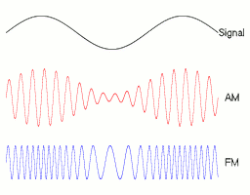
Back بث إذاعي بتضمين التردد Arabic FM-radio Azerbaijani এফএম সম্প্রচার Bengali/Bangla Ràdio FM Catalan FM via VHF bånd II Danish UKW-Rundfunk German Radio FM Esperanto Radio FM Spanish FM-raadioringhääling Estonian FM irrati Basque

In AM broadcasting, the amplitude of the carrier wave is modulated to encode the original sound. In FM broadcasting, the frequency of the carrier wave is modulated to encode the sound. A radio receiver extracts the original program sound from the modulated radio signal and reproduces the sound in a loudspeaker.


FM broadcasting is a method of radio broadcasting that uses frequency modulation (FM) of the radio broadcast carrier wave. Invented in 1933 by American engineer Edwin Armstrong, wide-band FM is used worldwide to transmit high-fidelity sound over broadcast radio. FM broadcasting offers higher fidelity—more accurate reproduction of the original program sound—than other broadcasting techniques, such as AM broadcasting. It is also less susceptible to common forms of interference, having less static and popping sounds than are often heard on AM. Therefore, FM is used for most broadcasts of music and general audio (in the audio spectrum). FM radio stations use the very high frequency range of radio frequencies.
© MMXXIII Rich X Search. We shall prevail. All rights reserved. Rich X Search